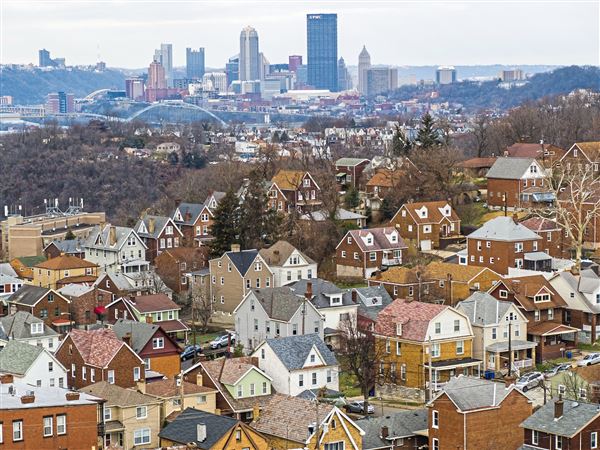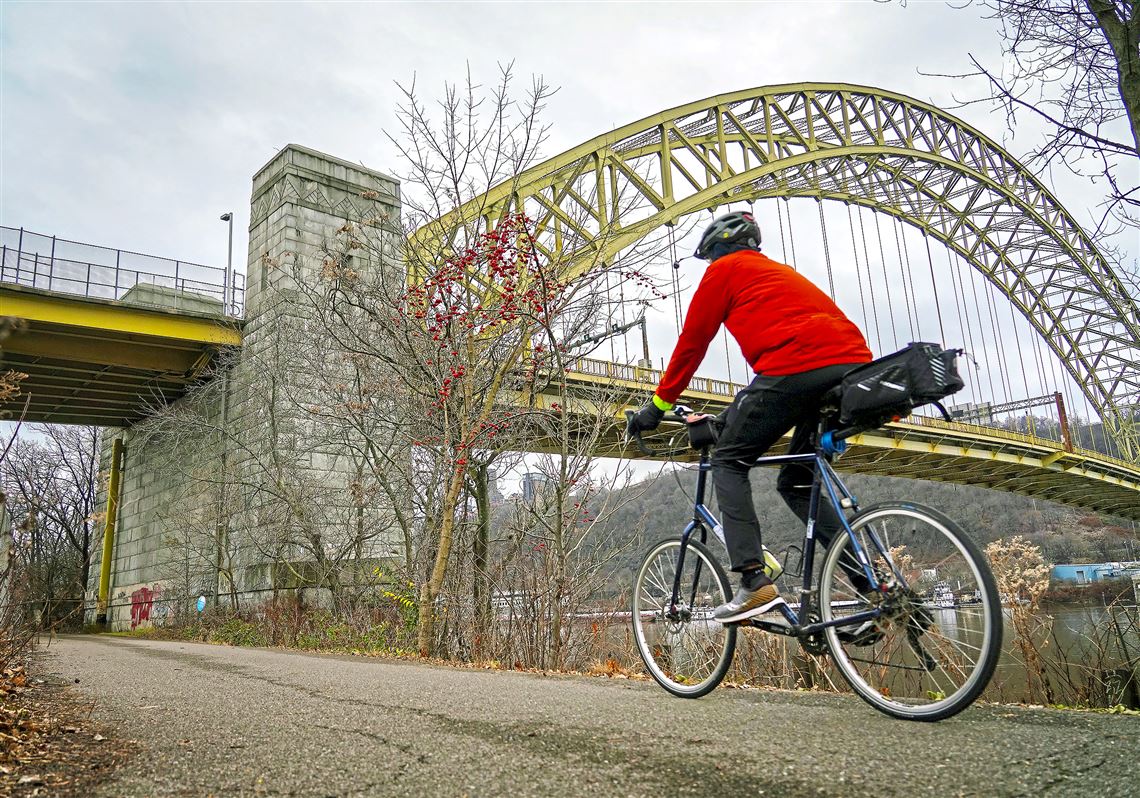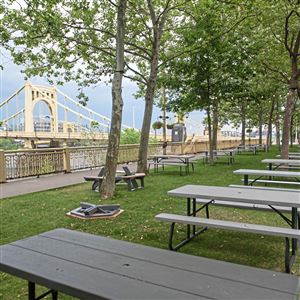Riverlife’s ambitious plan to finish trail and parks gaps along 15 miles of riverfront around the Golden Triangle will come with a hefty price tag: an estimated $246.8 million.
The plan, in development for several years, includes establishing a scenic walkway on the West End Bridge facing the Point as well as parks on the riverbanks on each side of the bridge; converting the old city tow pound in the Strip District into a park that includes a ramp to the 31st Street Bridge; and extending South Side Riverfront Park to Station Square.
Other pieces include improving the Monongahela Wharf and its connection with Point State Park; revamping the trail beside River Avenue along the Allegheny River on the North Side, and improving North Side neighborhood connections with North Shore amenities.
The advocacy agency quietly released a 248-page report last week detailing the projects, providing artist’s renderings and estimating the cost for the 10-year plan that stretches from the 31st Street Bridge on the Allegheny River to the West End Bridge on the Ohio and the Hot Metal Bridge on the Monongahela. This series of projects, called “completing the loop,” is a followup to the agency’s $4.2 billion riverfront investment over the past two decades that led to such amenities as trail extensions and construction of the park between the stadiums on the North Shore and the South Side Riverfront Park behind SouthSide Works.
Matt Galluzzo, Riverlife’s president and CEO, said he expects a more public rollout of the report’s recommendations over the next six months. The agency developed the recommendations after taking ideas from thousands over the past two years through a process coordinated by consultant evolveEA.
“We heard loud and clear from people that they want these kinds of improvements,” Mr. Galluzzo said. “I think there’s a legitimate concern about meeting the needs of Pittsburghers. We heard, ‘We want more, we want it big and we want it now.’”
The largest proposal is a $115.9 million series of changes around the West End Bridge, which Mr. Galluzzo said could become a “world-class tourist destination.” In addition to doubling the width of the walkway on the bridge itself and adding colorful lights at night, plans call for installing switchback ramps on each end to new river-level parks in Manchester and the West End.
The existing narrow walkway “really isn’t a place you would want to go right now,” Mr. Galluzzo said, but the potential is “breathtaking.” Wider walkways with scenic overlooks would provide “amazing” views of Downtown Pittsburgh over the Point as well as up the Monongahela and Allegheny valleys.
The timing of this project is tied to the Pennsylvania Department of Transportation’s plans to rehabilitate the century-old bridge beginning in 2028. Riverlife received a $100,600 grant late last year from the state Department of Conservation and Natural Resources to study whether the bridge could accommodate a wider walkway.
The walkway is a key to connecting riverfront trails on each side of the bridge; the new parks under each end of the bridge are designed to enhance that connection.
On the Manchester side, the Manchester Gateway Park would convert a parking lot beneath the bridge into a park along the riverbank with trailhead parking and shops. The area could have a heavy art presence, including a serpentine ramp suspended between the ground and the bridge to connect Manchester with the river.
Another goal is providing an easier pedestrian link between the riverfront and North Side’s Western Avenue business district.
The new park also would dovetail with the proposed Esplanade development in Manchester that could include apartments, a giant Ferris wheel and a splash park.
Mr. Galluzzo said Riverlife considers the Manchester work an “equity” project since that area didn’t receive much benefit from the first round of riverfront improvements.
On the other side, Saw Mill Run Gateway Park would act as another trailhead with small commercial buildings with a cafe or kayak rentals; incubator space for artists or nonprofits; a small boat dock; and a trail connecting to Station Square.
In the Strip District, Riverlife is proposing City Landing Park, a $68.7 million complex beneath the 31st Street Bridge on 14 acres around the city’s former tow pound. The park would include several small commercial buildings and park space leading to steps to the river, similar to those on the Allegheny River side of Point State Park.
At the river, the park would have a dock for boats and its signature attraction: a barge for swimming.
“New park and river oriented commercial spaces would invite people to the park and provide much-needed amenities along the riverfront.” the study said. “Visitors can enjoy a variety of active and passive recreation opportunities and experience different outdoor rooms with swings, benches, or other creative ways to watch the river.”
The park would be adjacent to one of the city’s fastest-growing residential areas that also is seeing commercial redevelopment in its iconic market area.
On the South Side, the plan is to extend South Side Riverfront Park several blocks to Station Square, eliminating a gap around industrial buildings at Fourth Street, at a cost of $27 million. Work would include a trail extension between the private Highline development at Fourth Street and the Monongahela River and adding a bridge-to-shore ramp at the Philip Murray Bridge at South 10th Street as well as more boat docks.
The other signature projects include improving Allegheny Riverfront Park between the Point and the Clemente Bridge ($18.3 million); creating a trailhead along River Avenue on the North Side near the 31st Street Bridge ($13.9 million); and renovating Allegheny Landing between the Clemente and Warhol bridges on the North Shore ($3.4 million).
Mr. Galluzzo said Riverlife’s role now shifts to pushing for funding for the projects and in many cases acting as a project manager. Work will begin with what he called “low-hanging fruit” such as Allegheny Landing, where some work already has started, and Allegheny Riverfront Park, where the Pittsburgh Downtown Partnership last year closed nearby Fort Duquesne Boulevard for a pop-up park to draw people back Downtown during the pandemic.
Other projects will take five to 10 years to complete.
“It certainly is an aggressive timeline,” Mr. Galluzzo said. “I think we owe it to the region to meet that and deliver the world-class riverfronts we deserve.”
Something the agency learned from its previous efforts, Mr. Galluzzo said, is to include long-term maintenance money as part of the budget for every project. The study found that just over 50% of the existing riverfront park and trail facilities are in need of upgrades, a factor the agency is working to address with the city’s Department of Mobility and Infrastructure and advocacy group Friends of the Riverfront.
“There was a mentality that once we created this environment, that was it,” he said.
With its latest projects, such as South Side Riverfront Park, there is a long-term maintenance fund. As a result, he said, that park remains in “pristine” condition.
Mayor Ed Gainey’s administration released a statement in which the mayor said he’s looking forward to working with Riverlife on the projects.
"We are proud to collaborate with Riverlife because they are an organization that does tremendous work to bring the benefits of river life to our city,” the statement said. “We look forward to reviewing the plan over the coming weeks to learn how we can collaborate to expand river front access in our city."
Ed Blazina: eblazina@post-gazette.com, 412-263-1470 or on Twitter @EdBlazina.
First Published: March 27, 2022, 10:00 a.m.





















